“William Shakespeare’s sonnet 130 “My mistress’ eyes are nothing like the sun”.
Урок літератури Англії (спецкурс для спеціалізованих шкіл з поглибленим вивченням англійської мови) або ж можна використати як інтегрований урок англійської мови
English literature lesson
Form: 10
“William Shakespeare’s sonnet 130 “My mistress’ eyes are nothing like the sun”.
Objectives: by the end of the lesson learners will be able to analyze the sonnet 130 (the language of the sonnet, its structure, métiers), make own literary translation of the sonnet, compare the original with translations made by famous poets.
Materials: schemes and tables, pictures, audio and video recording of the Shakespeare’s sonnet, portrait of the dark lady.
Procedures
I. Introduction
Teacher: Good morning, dear students. Get ready to start our lesson. Check, please, if you have everything you need for the lesson on your desks.
(On the blackboard there’s a quotation of Percy Bysshe Shelley)
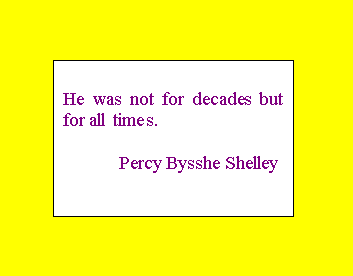
Teacher: Look at the quotation at the blackboard and try to guess who the person these words were devoted to was.
Students: William Shakespeare
Teacher: That is right. Today we will continue our acquaintance with William Shakespeare and will concentrate on his sonnets. We will learn what the sonnet is, its structure, and we will make analyses of the sonnet 130 and compare Shakespeare’s sonnet with a great number of its translations.
1. Warm-up
(On the blackboard there are several schemes and tables)
Teacher: On the lessons of World Literature you have already met such type of the poems as a sonnet. So what is the sonnet?
Students: Sonnet is a type of a poem.
Teacher: How many lines does it contain?
Students: 14 lines
Teacher: You are right. Let’s check your answers and read the first scheme.
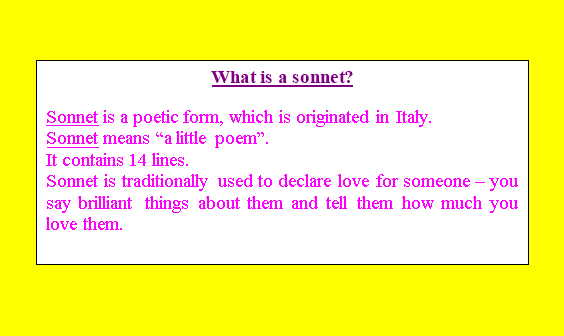
II. Introduction to new material
1.Presentation
Teacher: William Shakespeare wrote 154 sonnets. They all are divided into 4 groups and combined around the same general topic. Let’s get acquainted to them.
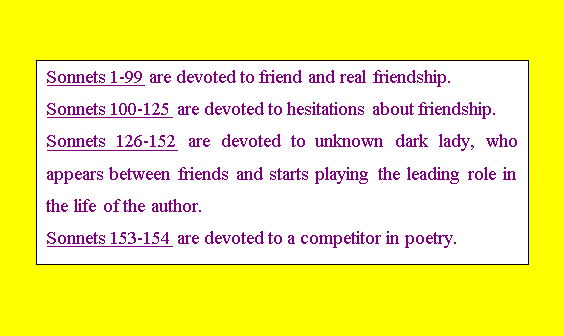
Teacher: Every sonnet is written according to several main rules or principles. They are in its structure.
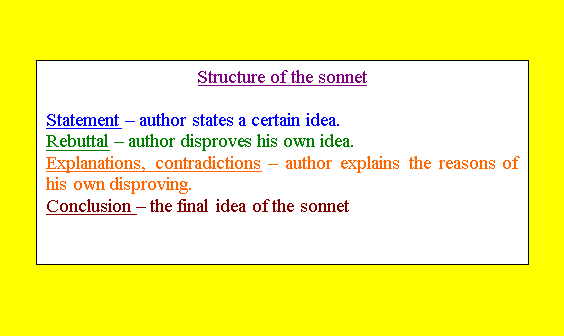
(On the blackboard there is a picture of a dark lady and the text of the sonnet 130)
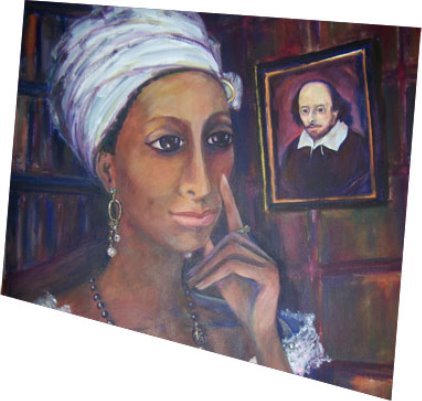
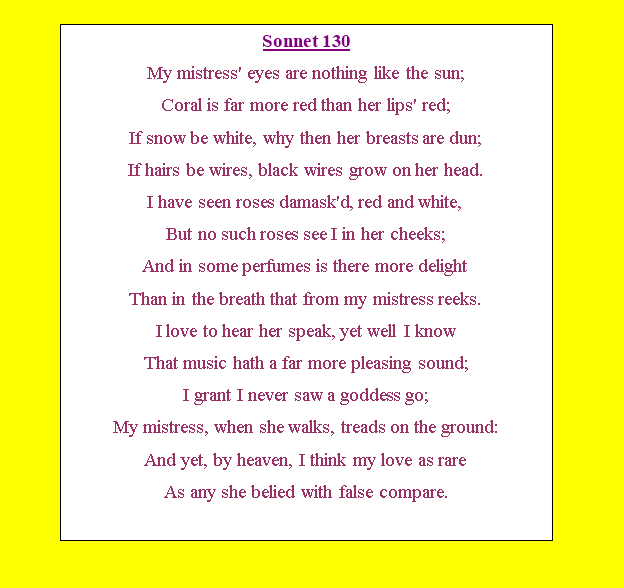
2. Listening
Teacher: Now listen to the sonnet 130 and answer the question, who is the main hero of it. (Allan Rickman reads the sonnet)
https://www.youtube.com/watch?v=xP06F0yynic&feature=youtu.be
Students: The dark lady is in the center of the sonnet, it is devoted to her.
III. Guided practice
1.Analyses of the sonnet
1.1 Answering the questions
Teacher: Look through the text of the sonnet and say what is the statement of the sonnet?
Students: The lady is not ideal.
Teacher: What is the rebuttal and explanation of the sonnet?
Students: This lady is not the goddess but a real woman with her minuses.
Teacher: What is the conclusion?
Students: This real woman is beautiful for the poet and he loves her as she is.
1.2 Marking the stressed words in the sonnet
Teacher: Listen to the sonnet once again and mark the stressed words in it.
(Students are listening to the sonnet one more time and marking the stressed words in it)
Teacher: Which words are stressed?
Students:
1.Eyes,nothing like the sun,
2.Coral, far more red, her lips,
3.Snow, white, breasts, dun,
4.Hair, wires, black wires,
5.Roses damask’d, red, white, no roses, her cheek,
6.Perfumes, delight, breath, reeks,
7.Love, hear, speak, music, far more pleasing sound,
8.Grant, never saw, goddess go,
9.My mistress treads,
10.Love, as rare, as any she.
Teacher: How do you think, why these words are stressed?
Students: To underline the comparison and to show the main idea, which author wanted to explain in the sonnet.
Teacher: Can we identify the rhyme scheme of the sonnet?
Students: Yes. It is iambic pentameter.
Teacher: That is right. Look at the blackboard on the slides.
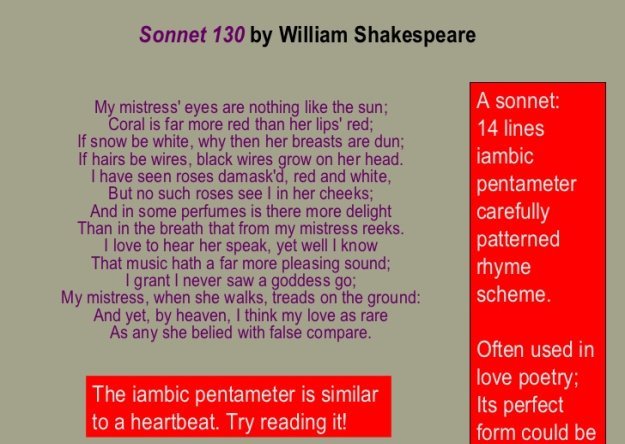
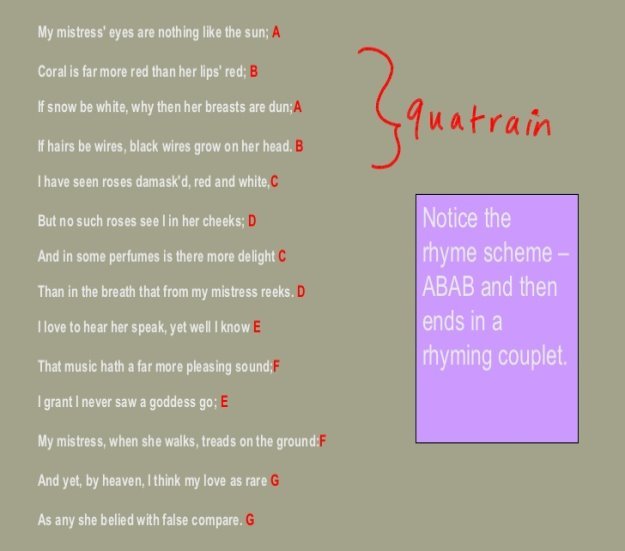
1.3Métiers analyses
Teacher: Now we have to find the words or phrases in the sonnet which author uses to describe his beloved.
Teacher: In traditional comparison lips and eyes of a woman are compared to something beautiful. What do we see here?
Students: “My mistress’ eyes are nothing like the sun”, word “nothing” is a criticism here. Author underplays how beautiful his mistress is.
Students: “Coral is far more red than her lips red”, it means that her lips are not red as it could be desired; “If snow be white, why then her breasts are dun” – author shows that his mistress’ breasts are brown or dark, not white as it was popular at that time.
Students: Author compares her hair with black wires growing on her head. But women with blonde hair were considered to be beautiful.
Students: William Shakespeare also mentions roses in the sonnet. It was traditionally that women were compared with roses but he says that his beloved has nothing common with roses; she even doesn’t have any shadow of roses on her cheeks.
Students: He compares her breath with perfumes and says that “in some perfumes is there more delight than in the breath” of dark lady.
Students: William Shakespeare says that his beloved treads on the ground, stressing that she is not a goddess but a real person.
Teacher: So does the poet think his woman is beautiful or no?
Students: Yes, he does. In last 2 lines we can see the direct statement, telling us what he thinks. Poet is sure his woman is beautiful. But he doesn’t want to describe her in a clichéd way. He says that she is beautiful as any other woman who is praised with false comparisons.
Teacher: Well done! You are very right. Let’s write the main points of our conclusion on the blackboard.
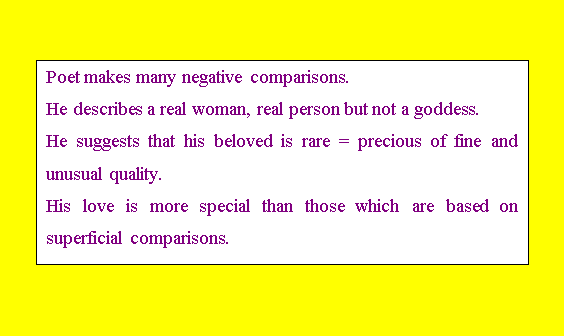
IV. Free practice
1. Literary translation
Teacher: Now try to write down your own literary translation of the sonnet. And then we will check and compare your variants.
(Students write their own translations, read them in class, discuss and choose the best chosen phrases for translation.)
Teacher: Now I would like you to read the translations of the sonnet 130 made by famous poets. We have to read them and compare with the original version.
1.Comparison with translation made by poets
До сонця не подібні очі милі,
Не схожі на корал її вуста,
Смагляві груди й плечі, а не білі,
Коса – як чорний дріт, не золота.
Трояндою не квітне поцілунок,
І, зовсім вже поетові на глум,
У дихання і тіла звичний трунок,
Як у людей, не схожий на парфум.
Не бачив я богинь, не довелося,
Та чув, що мають масу надлегку…
Йшла мила в шапці чорного волосся –
Лишався слід виразний на піску.
Хай брешуть поетичні порівняння:
Ти краща за усіх, моє кохання!
(Тетяна Лавинюкова)
Її очей до сонця не рівняли,
Корал ніжніший за її уста,
Не білосніжні пліч овали,
Мов з дроту чорного коса густа.
Троянд багато зустрічав я всюди,
Та на її обличчі не стрічав,
І дише так вона, як дишуть люди, –
А не конвалії між диких трав.
І голосу її рівнять не треба
До музики, милішої мені,
Не знаю про ходу богинь із неба,
А кроки милої цілком земні.
І все ж вона – найкраща поміж тими,
Що славлені похвалами пустими.
(Дмитро Паламарчук)
(Students read the translations and compare with the original)
V. The closing
1. Discussion
Teacher: Today we have spent one more lesson in the world of art created by William Shakespeare. What was new for you today?
Students: Information about sonnet 130.
Teacher: What is the sonnet?
Students: Sonnet is a poetic form, which is originated in Italy. Sonnet means “a little poem”. It contains 14 lines. Sonnet is traditionally used to declare love for someone – you say brilliant things about them and tell them how much you love them.
Teacher: What summary of the sonnet 130 would you write?
Students: Sonnet 130 is like a love poem turned on its head. Usually, if you were talking about your beloved, you would go out of your way to praise her, to point all the ways that she is the best. In this case, though, Shakespeare spends this poem comparing his mistress's appearance to other things, and then telling us how she doesn't measure up to them. He goes through a whole laundry list, giving us details about the flaws of her body, her smell, even the sound of her voice. Then, at the end, he changes his tune and tells us about his real and complete love for her.
2. Hometask
Teacher: Today all of you worked very well and I’m sure you had enjoyed the beauty of the literary world created by William Shakespeare. We proved today that his works were not for a year or a decade but for all times. I would like to give you a little challenge as your homework – to write own analyses of the sonnet 18 and to write your own literary translation of it.


про публікацію авторської розробки
Додати розробку
